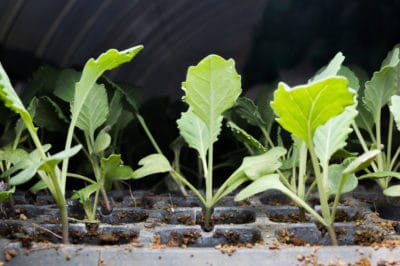Types of Kale Seedlings to Consider
If you have a small space and you are planning a container garden, consider dwarf varieties such as:
- Dwarf Siberian
- Improved Dwarf Siberian
- Dwarf Blue Curled (also known as Dwarf Blue Curled Scotch, Dwarf Blue Curled Vates, and other similar variations
In your garden, consider popular varieties such as:
- Lacinato, also known as Tuscan Kale and Cavolo Nero
- Blue Curled Kale
- Red Russian Kale
- Winterbor
While Lacinato adds a mild, nutty flavor to kale’s generally sweet taste and is preferred by many for salads, Blue Curled Kale and Red Russian Kale mix an assertive, peppery, pungent, bitter edginess with the sweetness that is sought after in recipes. Some feel that Red Russian Kale is milder than Blue Curled Kale, though. You can purchase different varieties in your grocery’s produce department or at a local farmer’s market for a taste test before making up your mind.
Starting Seedlings From Seeds
If you want to start your seedlings indoors yourself for spring planting, you should plant the seeds five to seven weeks before the last frost date in your area. Plant the seeds 1 inch apart and cover them with ¼ inch to ½ inch of soil. Choose a loamy potting soil that is blended for vegetables or vegetables and herbs. Allow the top layer to dry out between each watering, but keep the soil moist at a depth of 1 inch.
When the seeds sprout or germinate, the first two leaves that appear are the cotyledons and not true leaves. They are part of the seed, like the tiny plant that you see between the two halves of a roasted peanut. They provide nourishment for the plant while the root system and the true leaves develop.
Wait to thin your seedlings until they are 3 inches to 4 inches tall and have four true leaves with two more on the way. Leave about 12 inches between your seedlings when you thin them.
To have an ample supply of kale, you should have three to four plants for each person in your household, but plant extra to allow for guests and the untimely demise of some plants.
You can transplant the kale you thin out to another container, use the leaves for flavoring in a soup or stew, or drop the plants into your compost.
When to Transplant Seedlings
Whether you buy them or grow your own, you can transplant your seedlings two to four weeks before the last frost date in your area. Because kale’s pests emerge in search of a meal at about the time they expect to find a kale dinner waiting for them, you can disappoint them and send them freeloading elsewhere by delaying planting your kale by two weeks.
Where to Plant Seedlings
Kale likes full sun to partial shade, and, in the early spring, the full sun provides warmth. For planting later in the growing season, consider planting kale where some shade protects it from the heat of summer when temperatures above 80°F (67°C) can cause kale’s leaves to become tough and bitter.
You should avoid planting kale in areas that remain muddy for extended periods or where water creates standing puddles. Look for well-drained areas of loamy or sandy soil where the soil remains moist at a depth of 1 inch but where the soil’s surface layer dries out.
The soil’s pH balance should be between 5.5 and 6.8. If the number is too low, your soil is too acidic, but adding wood ash corrects the problem.
How to Plant Seedlings
If you are planting your seedlings in containers, each plant needs 6 inches to 12 inches of space. In the garden, space rows 18 inches apart, and plant your seedlings 12 inches to 18 inches apart. Place each plant so that it is upright, and plant it deeply enough that the soil supports the stem without covering the leaves.
